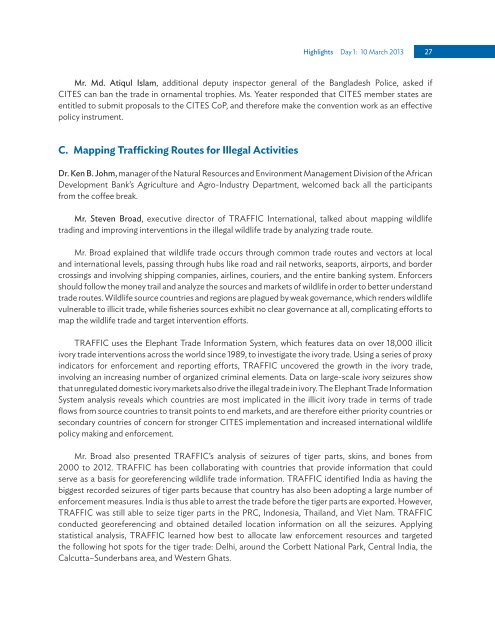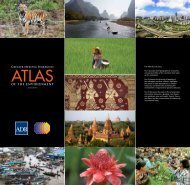ETEE7
ETEE7
ETEE7
Create successful ePaper yourself
Turn your PDF publications into a flip-book with our unique Google optimized e-Paper software.
Highlights Day 1: 10 March 2013 27<br />
Mr. Md. Atiqul Islam, additional deputy inspector general of the Bangladesh Police, asked if<br />
CITES can ban the trade in ornamental trophies. Ms. Yeater responded that CITES member states are<br />
entitled to submit proposals to the CITES CoP, and therefore make the convention work as an effective<br />
policy instrument.<br />
C. Mapping Trafficking Routes for Illegal Activities<br />
Dr. Ken B. Johm, manager of the Natural Resources and Environment Management Division of the African<br />
Development Bank’s Agriculture and Agro-Industry Department, welcomed back all the participants<br />
from the coffee break.<br />
Mr. Steven Broad, executive director of TRAFFIC International, talked about mapping wildlife<br />
trading and improving interventions in the illegal wildlife trade by analyzing trade route.<br />
Mr. Broad explained that wildlife trade occurs through common trade routes and vectors at local<br />
and international levels, passing through hubs like road and rail networks, seaports, airports, and border<br />
crossings and involving shipping companies, airlines, couriers, and the entire banking system. Enforcers<br />
should follow the money trail and analyze the sources and markets of wildlife in order to better understand<br />
trade routes. Wildlife source countries and regions are plagued by weak governance, which renders wildlife<br />
vulnerable to illicit trade, while fisheries sources exhibit no clear governance at all, complicating efforts to<br />
map the wildlife trade and target intervention efforts.<br />
TRAFFIC uses the Elephant Trade Information System, which features data on over 18,000 illicit<br />
ivory trade interventions across the world since 1989, to investigate the ivory trade. Using a series of proxy<br />
indicators for enforcement and reporting efforts, TRAFFIC uncovered the growth in the ivory trade,<br />
involving an increasing number of organized criminal elements. Data on large-scale ivory seizures show<br />
that unregulated domestic ivory markets also drive the illegal trade in ivory. The Elephant Trade Information<br />
System analysis reveals which countries are most implicated in the illicit ivory trade in terms of trade<br />
flows from source countries to transit points to end markets, and are therefore either priority countries or<br />
secondary countries of concern for stronger CITES implementation and increased international wildlife<br />
policy making and enforcement.<br />
Mr. Broad also presented TRAFFIC’s analysis of seizures of tiger parts, skins, and bones from<br />
2000 to 2012. TRAFFIC has been collaborating with countries that provide information that could<br />
serve as a basis for georeferencing wildlife trade information. TRAFFIC identified India as having the<br />
biggest recorded seizures of tiger parts because that country has also been adopting a large number of<br />
enforcement measures. India is thus able to arrest the trade before the tiger parts are exported. However,<br />
TRAFFIC was still able to seize tiger parts in the PRC, Indonesia, Thailand, and Viet Nam. TRAFFIC<br />
conducted georeferencing and obtained detailed location information on all the seizures. Applying<br />
statistical analysis, TRAFFIC learned how best to allocate law enforcement resources and targeted<br />
the following hot spots for the tiger trade: Delhi, around the Corbett National Park, Central India, the<br />
Calcutta–Sunderbans area, and Western Ghats.





